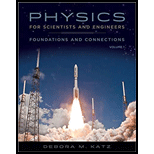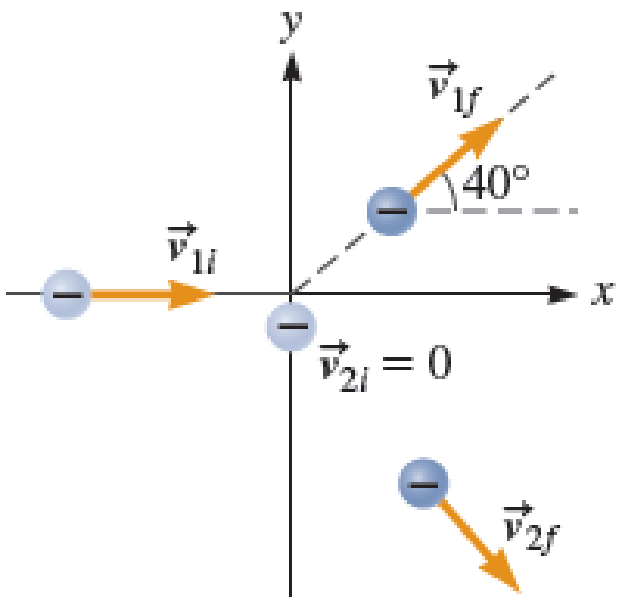
In a laboratory experiment, an electron with a kinetic energy of 50.5 keV is shot toward another electron initially at rest (Fig. P11.50). (1 eV = 1.602 × 10−19 J) The collision is elastic. The initially moving electron is deflected by the collision.
- a. Is it possible for the initially stationary electron to remain at rest after the collision? Explain.
- b. The initially moving electron is detected at an angle of 40.0° from its original path. What is the speed of each electron after the collision?

FIGURE P11.50
(a)
Whether it is possible for the initially stationary electron to remain at rest after the collision.
Answer to Problem 50PQ
It is not possible for the initially stationary electron to remain at rest after the collision.
Explanation of Solution
The elastic collision is characterized by the conservation of momentum as well as kinetic energy. For an elastic collision initial momentum of the system before collision should be equal to the momentum of the system after collision.
In the given situation, the initial momentum of the system in
Conclusion:
Thus, it is not possible for the initially stationary electron to remain at rest after the collision.
(b)
The speed of each electron after the collision.
Answer to Problem 50PQ
The speed of initially moving electron after the collision is
Explanation of Solution
The given situation is a two-dimensional elastic collision between two particles of equal mass with initial velocity for one of the particle equal to zero. For such a collision, the angle between the final velocities of the particles after the collision will be equal to
Here,
Rearrange the above equation for
It is given that the value of
Substitute
Write the expression for the conservation of momentum in
Here,
Write the expression for
Here,
Substitute
Write the expression for
Here,
Substitute
Put equations (II) and (III) in equation (I).
The momentum in
Write the expression for the conservation of momentum in
Here,
Write the expression for
Substitute
Write the expression for
The negative sign is due to the fact that the electron 2 moves in negative
Substitute
Put equations (VI) and (VII) in equation (V) and rearrange it for
Put the above equation in equation (IV) and rearrange it for
Put equation (IX) in equation (VIII).
Write the equation for the initial kinetic energy of electron 1.
Here,
Rewrite the above equation for
Conclusion:
It is given that the initial kinetic energy of electron 1 is
Substitute
Substitute
Substitute
Therefore, the speed of initially moving electron after the collision is
Want to see more full solutions like this?
Chapter 11 Solutions
Student Solutions Manual For Katz's Physics For Scientists And Engineers: Foundations And Connections, Volume 1
- A football player of mass 95 kg is running at a speed of 5.0 m/s down the field as shown in Figure P11.53. A second player of mass 140 kg, running at a speed of 2.5 m/s, tackles the first player so that they move together after the collision. What is the velocity of the two players immediately after the collision? FIGURE P11.53 53. The football players have the same final velocity in this inelastic collision. We can use Equations 11.24 and 11.25 to determine the x and y components of the final velocity. The lighter player (95 kg) moves vertically, so v1ix = 0 and v1iy = 5.00 m/s. The other player (140 kg) moves to the right, so v2ix = 2.5 m/s and v2iy = 0. Therefore, m1v1ix+m2v2ix=(m1+m2)vfx(140kg)(2.5m/s)=(95kg+140kg)vfxvfx=1.5m/sm1v1iy+m2v2iy=(m1+m2)vfy Chapter 11 Collisions11.31 (95kg)(5.00m/s)=(95kg+140kg)vfyvfy=2.0m/s The final velocity is then vf=(1.5i+2.0j)m/sarrow_forwardA particle has a momentum of magnitude 40.0 kg m/s and a kinetic energy of 3.40 102 J. a. What is the mass of the particle? b. What is the speed of the particle?arrow_forwardA bullet of mass m = 8.00 g is fired into and embeds itself in a large 1.50-kg block of wood, initially at rest. What was the original speed of the bullet if that block with the embedded bullet were moving at a speed of 1.10 m/s immediately after the collision?arrow_forward
- In an attempt to produce exotic new particles, a proton of mass mp = 1.67 1027 kg is accelerated to 0.99c (c = 3.00 108 m/s is the speed of light) and crashed into a helium nucleus of mass mHe = 6.64 1027 kg initially at rest. The collision is elastic. a. What is the kinetic energy of the helium nucleus after the collision? b. What is the kinetic energy of the proton after the collision? (In Chapter 39, well learn what Einstein says about making such calculations.)arrow_forward(a) Calculate for a proton that has a momentum of (b) What is its speed? Such protons form a rare component of cosmic radiation with uncertain origins.arrow_forwardAn object of mass m = 4.00 kg that is moving with a speed of 10.0 m/s collides head-on with another object, and the collision lasts 1.50 s. A graph showing the magnitude of the force during the collision versus time is shown in Figure P11.59, where the force is exerted in the direction opposite the initial velocity. Find the speed of the 4.00-kg mass after collision. FIGURE P11.59arrow_forward
- A car crashes into a large tree that does not move. The car goes from 30 m/s to 0 in 1.3 m. (a) What impulse is applied to the driver by the seatbelt, assuming he follows the same motion as the car? (b) What is the average force applied to the driver by the seatbelt?arrow_forwardA particle of mass m moving along the x-axis with a velocity component +u collides head-on and sticks to a particle of mass m/3 moving along the x-axis with the velocity component −u. What is the mass M of the resulting particle?arrow_forwardTwo pucks in a laboratory are placed on an air table. Puck 1 has twice the mass of puck 2. They are pushed toward each other and strike in a head-on collision. Initially, puck 2 is twice as fast as puck 1. a. What is the total momentum before the collision? b. What is the center-of-mass velocity before the collision? c. If the pucks are initially 2.70 m apart, how far did puck 1 move before the collision?arrow_forward
- A 2.0-g particle moving at 8.0 m/s makes a perfectly elastic head-on collision with a resting 1.0-g object. (a) Find the speed of each particle after the collision. (b) Find the speed of each particle after the collision if the stationary particle has a mass of 10 g. (c) Find the final kinetic energy of the incident 2.0-g particle in the situations described in parts (a) and (b). In which case does the incident particle lose more kinetic energy?arrow_forward(a) Find the momentum of a asteroid heading towards Earth at 30.0 km/s. (b) Find the ratio of this momentum to the classical momentum. (Hint: Use the approximation that at low velocities.)arrow_forward
 Physics for Scientists and Engineers: Foundations...PhysicsISBN:9781133939146Author:Katz, Debora M.Publisher:Cengage Learning
Physics for Scientists and Engineers: Foundations...PhysicsISBN:9781133939146Author:Katz, Debora M.Publisher:Cengage Learning College PhysicsPhysicsISBN:9781305952300Author:Raymond A. Serway, Chris VuillePublisher:Cengage Learning
College PhysicsPhysicsISBN:9781305952300Author:Raymond A. Serway, Chris VuillePublisher:Cengage Learning Glencoe Physics: Principles and Problems, Student...PhysicsISBN:9780078807213Author:Paul W. ZitzewitzPublisher:Glencoe/McGraw-Hill
Glencoe Physics: Principles and Problems, Student...PhysicsISBN:9780078807213Author:Paul W. ZitzewitzPublisher:Glencoe/McGraw-Hill Principles of Physics: A Calculus-Based TextPhysicsISBN:9781133104261Author:Raymond A. Serway, John W. JewettPublisher:Cengage Learning
Principles of Physics: A Calculus-Based TextPhysicsISBN:9781133104261Author:Raymond A. Serway, John W. JewettPublisher:Cengage Learning Modern PhysicsPhysicsISBN:9781111794378Author:Raymond A. Serway, Clement J. Moses, Curt A. MoyerPublisher:Cengage Learning
Modern PhysicsPhysicsISBN:9781111794378Author:Raymond A. Serway, Clement J. Moses, Curt A. MoyerPublisher:Cengage Learning University Physics Volume 1PhysicsISBN:9781938168277Author:William Moebs, Samuel J. Ling, Jeff SannyPublisher:OpenStax - Rice University
University Physics Volume 1PhysicsISBN:9781938168277Author:William Moebs, Samuel J. Ling, Jeff SannyPublisher:OpenStax - Rice University





